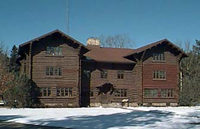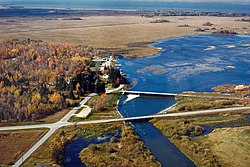Chippewa National Forest
| Chippewa National Forest | |
|---|---|
 | |
| Location | Itasca / Cass / Beltrami counties, Minnesota, United States |
| Nearest city | Cass Lake, MN |
| Coordinates | 47°20′26″N 94°12′24″W / 47.34056°N 94.20667°W |
| Area | 666,623 acres (2,697.73 km2)[1] |
| Established | 1908 |
| Governing body | U.S. Forest Service |
| Website | Chippewa National Forest |

Chippewa National Forest is a
.History
The Forest was established as the Minnesota Forest Reserve on 27 June 1902, with passage of the
Led by
The Lost Forty
The Forest contains an area known as the Lost Forty. This area, which has a total of 144 acres (0.58 km2), was accidentally mapped as part of Coddington Lake when the original maps of the region were laid out in 1882.
Historic and cultural sites

There are over 3000 archeological and historic sites located within the forest, two that are most notable and open to the public are:
- Camp Rabideau a Civilian Conservation Corps (CCC) camp is one of the best-preserved of the nation's many CCC camps.
- The Chippewa National Forest Historic Supervisor's Office, constructed by the Civilian Conservation Corps and Works Project Administration.
Geography
The forest covers 667,094 acres (2,699.63 km2). Water is abundant, with over 1,300 lakes, 923 miles (1,485 km) of rivers and streams and 400,000 acres (1,600 km2) of wetlands.[6] The Forest has more lakes and wetlands than any other National Forest in the nation, boasting approximately 13% of all surface water within the entire National Forest system.[7] Inside the forest the Cut Foot Sioux Trail runs along the Laurentian Divide.
Three of the top ten largest lakes in size within the State of Minnesota are located within the forest, these are Cass Lake, Leech Lake and Lake Winnibigoshish. Approximately 44% of the Forest's land is within the Leech Lake Indian Reservation.
Fauna and flora
Recreation

The Forest contains 21 developed campgrounds, 41 miles of paved bike trails, 43 miles of unpaved bike trails, 160 miles of hiking trails, 298 miles of non-motorized trails, 380 miles of snowmobile trails, 68 dispersed camping locations, 20 miles of horse trails, 83 boat accesses.[10]
A highlight of the Forest's trail system is the 60-plus mile segment of the
Visitor Centers
The Forest operates three visitor centers in the forest, they are:[11]
- Cut Foot Sioux Visitor Center – near Deer River, open Memorial Day weekend through Labor Day weekend.
- Edge of the Wilderness Discovery Center – near Marcell, open year-round.
- Norway Beach Visitor Center – near Cass Lake, open Memorial Day weekend through Labor Day weekend.
Scenic Byways
Many roadways, including U.S. and State Highways and county roads intersect the forest for easy access to the forest. Within the Forest are five scenic byways for scenic drives for visitors that intersect through the forest.[12]
- Great River Road, follows the Mississippi River within the Forest
- Edge of the Wilderness National Scenic Byway
- Avenue of the PinesNational Forest Scenic Byway
- Lake Country Scenic Byway
- Lady Slipper Scenic Byway, named for the Minnesota State Flower Pink-and-white Lady's-slipper, which can be found in the Forest.
See also
- Superior National Forest
- List of U.S. national forests
- List of Minnesota trees
References
- ^ "Land Areas of the National Forest System" (PDF). U.S. Forest Service. January 2012. Retrieved 20 June 2012.
- ^ 32 Stat., 400
- ^ Brady, Tim (November 2004). "The Real Story of Chippewa National Forest". Minnesota DNR Conservation Volunteer magazine. Archived from the original on 22 November 2022. Retrieved 26 March 2022.
- ^ 35 Stat., 268
- ^ "Lost forty history", Forest Service, Retrieved 2 September 2015
- ^ www.fs.fed.us http://www.fs.fed.us/r9/forests/chippewa/about/forest_facts/index.php. Retrieved 18 July 2006.
{{cite web}}: Missing or empty|title=(help)[title missing] - ^ "Chippewa National Forest - About the Forest". Fs.usda.gov. Retrieved 17 September 2022.
- ^ www.fs.fed.us http://www.fs.fed.us/r9/forests/chippewa/recreation/wildlife_viewing/. Retrieved 18 July 2006.
{{cite web}}: Missing or empty|title=(help)[title missing] - ^ "The Conservation Fund". www.conservationfund.org. Retrieved 18 July 2006.
- ^ "Chippewa National Forest - Recreation". Fs.usda.gov. Retrieved 16 September 2022.
- ^ "Chippewa National Forest - Outdoor Learning:Visitor Centers". Fs.usda.gov. Retrieved 16 September 2022.
- ^ "Chippewa National Forest - Scenic Driving". Fs.usda.gov. Retrieved 16 September 2022.
External links
- Official website
- History of the Forest "The Real Story of Chippewa National Forest" by Tim Brady in November–December 2004 issue of Minnesota Conservation Volunteer
- Online Map of the forest
- Print maps of the forest
- Brochure on "Lost 40" – USFS

